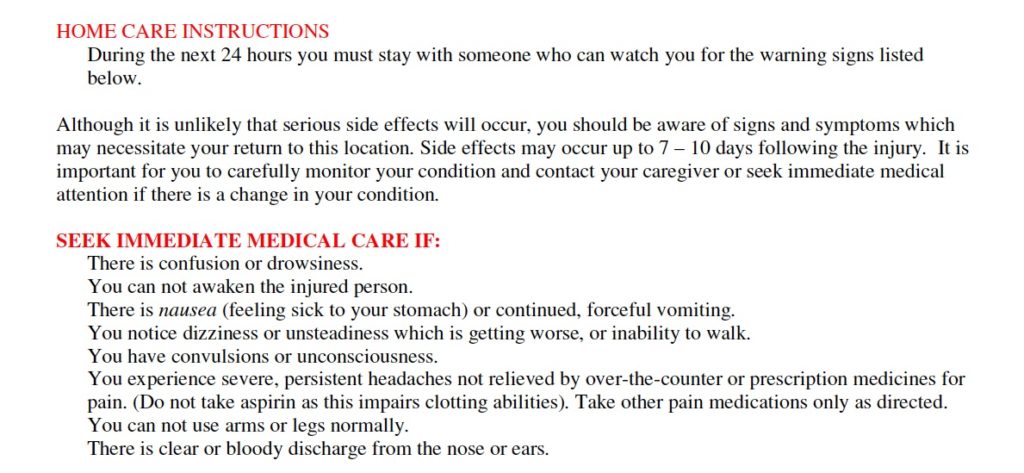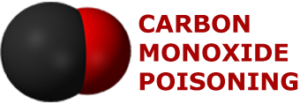Why are There no Standard Discharge Instructions for those Treated for Carbon Monoxide Poisoning?
800-992-9447
In contrast to the lack of discharge instructions for carbon monoxide poisoning, when I first began doing brain injury cases in 1992, “head injury discharge instructions” were the norm. Head injury discharge instructions are a mandated discharge paperwork that virtually anyone treated in the United States (and probably almost worldwide) is given after they have been treated/diagnosis with any sort of head injury, including concussion. The discharge instructions essentially say that head injury can get worse – not better – after leaving the emergency room; that people with head injuries should be not left alone, that they should be waken every hour or two, and if the symptoms worsen, especially with the onset of vomiting or other neurological signs, that they must be rushed back to the hospital.

Here is a standard discharge instruction for head injury. Why no comparable instruction for carbon monoxide poisoning?
Now in 2017, almost all concussions are treated as seriously as more severe head injuries were treated in 1992. Patients are warned to avoid return to play, to get evaluated in subsequent days and if an athlete, not allowed to return to play until function has returned to normal. I have harped in the past that civilian injuries (a term I use to pertain to any non-sport or non-military brain injury) often don’t get as good of attention as those in sports, but if the concussion is diagnosed in the emergency room, it is almost a given that some discharge instruction will be given.
No Warnings Given Relative to Delayed Problems after Carbon Monoxide Poisoning
In total contrast is what happens with someone who is treated for carbon monoxide poisoning. Unlike in cases of concussion, everyone who is treated for carbon monoxide poisoning should leave the ER with a definitive diagnosis, because carbon monoxide poisoning is susceptible to a blood test that if done within hours of the poisoning, can give a definitive result as to whether the person suffered the poisoning. The blood test is to determine whether the survivor has carboxyhemoglobin in his or her blood. Lab results will either say COHb and a percent, or give it in terms of carbon monoxide and a percent number. The numbers will be between 0 and 60 on a 100 point scale. The reason COHb number never exceeds 60 is that such levels are almost always fatal and the heart simply stops beating from lack of oxygen. Levels below 50 can be fatal in some people, depending on pre-exposure factors.
Why Carbon Monoxide Poisoning Discharge Warnings?
Why do we need carbon monoxide poisoning discharge instructions? Because the risk factors for problems after discharge are considerably higher than after a concussion. The motivation for the discharge instruction after a concussion is the risk of a ICP pressure event that might ultimately result in coma and or death. That is a very low risk factor after most concussions.
In contrast, the delayed onset of symptoms after carbon monoxide poisoning is a high probability, certainly above 40%. While people think of a brain damage event as evolving much like what we see in a boxing match, that is so clearly not the case in carbon monoxide poisoning. In a boxing match, if a boxer is stunned or knocked down, we expect that if they are able to get back to their feet within 10 seconds, and able to survive to the end of the round, that within another 60 seconds, they are likely to be able to conpete in the fight. While traumatic brain injuries also have evolving symptoms that do not involve ICP pressure events, the probability of permanent neuropsychiatric impairment is much closer to 10% than to 50%.
What do survivors of carbon monoxide poisoning need to be warned about? The onset of delayed symptoms (sometimes called DNS for delayed neurological sequelae) where the bodies immune system goes haywire in response to the perceived threat of poisoning. The vast majority of disability from carbon monoxide poisoning comes from the over reaction of the immunological system, not the hypoxia from carbon monoxide poisoning (lack of oxygen to the cell.) Just because a COHb level has been lowered to something close to normal, does not mean that the crisis the poisoning has set off has ended. For most of those who survive, the crisis is just beginning.
Think of the example of what happens inside of building which has sprinklers for fire protection. If someone were to light a cigarette lighter near the ceiling tile in such a building, odds are the cigarette lighter could do no more damage than charred a few tiles. Yet if the heat from that cigarette lighter or smoke generated thereby sets off the sprinkler system in the building, substantial damage to the building is guaranteed to result. It will not be the damage an uncontrolled fire would cause, but it will be substantial. Likewise, the sensing of the body of carbon monoxide in an abnormal concentration, sets off the bodies immune system in a way, that doesn’t get shut down, as soon as the threat of damage to cells from lack of oxygen ends. That reaction may continue for days, weeks and months. How a given person’s immune system responds to the threat, not how high the COHb level is, largely dictates whether they will be part of the 40% or more who have permanent brain damage, or the rest, who may have a full recovery.
What is most important to remember is that carbon monoxide is a poison. It is not just a matter of taking away something the body needs, but of inserting something into the body that is dangerous to the body. If only the oxygen deprivation issue is addressed, and not the poisoning aspect, then puzzling but significant disability will show up in survivors. Our medical system must plan for those long term issues and must warn the survivors.
Ultimately, almost all survivors of carbon monoxide poisoning should be given hyperbaric oxygen treatment, because only hyperbaric oxygen therapy seems capable of turning off the sprinkler system. In future blogs, we will address the nature of the delayed symptoms, what the discharger instructions should say and how important hyperbaric oxygen is for to avoid delayed onset symptoms.

June 2016 (Australia) – I ended up with CO induced encephalitis which led to Parkinsonism. Eighteen months later l am still declining despite dopamine agonists helping with the shuffling freezing gait I am stuck with due to the brain damage. I was never given oxygen therapy by the hospital and neither was my partner. Our COHb was not checked for several days. It should be within 4 hrs of the CO event! My partner suffered cardio-respiratory and vision problems. Our hands still turn bright red/purple and we get short of breath. Pets were affected too. This damage was from a wood fired heater with a blocked flue over 12 weeks of winter. It’s not just gas appliances or boilers which emit CO if not combusting properly. The first responders and hospital staff knew very little about CO or how to manage symptoms. We’re left high n’ dry to deal with the fallout alone. Oxygen therapy would have been key, even up to 2 years later.
We are sorry to hear about what happened to you but sadly not surprised by the poor treatment you have received. I hope the resources on here can help you persuade the doctors in Australia of the reality of what you are going through. If you have not had an MRI, it might help to show the severity of your poisoning. Particular focus should be put in looking at hippocampal atrophy if you do get the MRI.
Best of luck and our prayers are with you.
Attorney Gordon Johnson
I recently was exposed to Carbon Monoxide at the school I work for. For the past five years we have been complaining of the smell of gas in our school in sevearal areas. Nothing was ever done about it. Finally two weeks ago a parent complained. I told them it has been years we have complained. They had the build Manager come and inspect and they found nothing. The next day the board president called xcel energy and they came out. They located there has leaks in the main line entering the building. Right next to the dryer vent going into the school. I had noticed before all this I was having several symptoms such as hands tingling headaches neseau memory loss poor concentration. So I was concerned when they found the leaks. Nothing was said to anyone we had a gas leak. We went on about our day as usual with the children all there. Nobody was notified of the leak. I told my director I wanted to go to the dr so I filed workmans Comp. I went to the dr and they were closed so I went to the urgent care. I explained to them I had felt I was exposed to natural gas for the past five years. He had no concerns and told me to go on mon to workmans Comp dr By then I’m sure my levels had drop but my symptoms still today persist. I have been back to the dr twice and still no concern and no treatment of any kind. I still have My symptoms daily. Then the next week has was smelled again and they determined it was the regulator. Again no one was reported of this leak and our day went on as normal. Today I still have my symptoms and nobody at our school was told about the leak. Employees and parents are left in the dark. For years I have smelled gas in our school. Any suggestions on how I get someone to listen to me how Sanger and how many people may be affected by this. Brenda
I was exposed for months. I knew something was wrong with the furnace and with me. I reached the the point of vomiting and confusion but my partner kept telling me it fine, nothing is wrong, until the detectors finally went off. I called the furnace guy and we aired the house out overnight. I was so sick. I am disabled and housebound. My partner is not home much. When the guy got here the next day the level was at 49 still after airing out and he said he had to leave after 5 mins for he was feeling sick already. I never received medical care because my partner felt bad for not believing me and even though i continued to get worse b4 i got better if you can call it that ,he didnt want me to tell anyone because he didnt want anyone to think he wasnt taking good care of me(he was embarrassed) i was to sick and out of it to make any decisions. This was 2017 winter, and now im reading about all of these problems that i have developed over time, now what do i do? I was pickling in this stuff. I could have died, and how do i even begin to explain this to my doctor now, i grow more damaged and it is a “taboo” subject in our home now
This is a very interesting article about carbon monoxide which is insidious poison.
No wonder I feel the way I do.